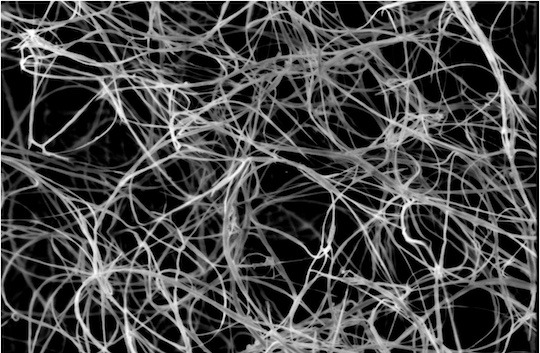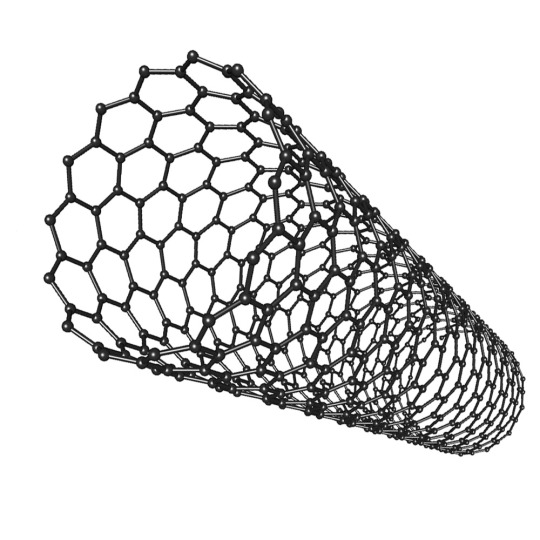#nanotubes
Text

Two-faced solar panels can generate more power at up to 70% less cost
Researchers have built a new kind of two-faced (bifacial) panel. They used single-walled carbon nanotubes as both front and back electrodes.
These tubes are just 2.2 nanometers across. That is slightly thinner than a strand of human DNA. A piece of paper is thicker than 45,000 nanotubes stacked on top of each other.
The study is published in the journal Nature Communications, and the team included Surrey scientists working with colleagues at the University of Cambridge, the Chinese Academy of Sciences, Xidian University, and Zhengzhou University, China.
Dr. Jing Zhang, research fellow at Surrey's Advanced Technology Institute, said, "Our bifacial cells can harvest sunlight from both front and back panels. This generates more energy and depends less on which angle the light hits them.
Read more.
#Materials Science#Science#Solar power#Carbon nanotubes#Nanotechnology#Carbon#Nanotubes#University of Surrey
56 notes
·
View notes
Video
youtube
An unfortunate naming accident
0 notes
Link
Rice University researchers have published a new theory for making batches of carbon nanotubes with a single, desired chirality. Their method could simplify purification of nanotubes that are all metallic or all semiconductors.
0 notes
Text
Rice University's Pioneering Research in Boron Nitride Nanotubes - Potential to fundamentally transform a multitude of industries - Hydrogen Storage and Spacecraft Manufacturing Among Them
Researchers at Rice University, under the guidance of Professor Angel Martí, have made a significant breakthrough in the field of material science by developing a novel method to create high-purity boron nitride nanotubes.
These nanotubes, cylindrical in shape and hollow, boast remarkable properties such as the ability to endure temperatures up to 900°C (approximately 1,652°F) and surpassing…

View On WordPress
8 notes
·
View notes
Text
youtube
4 notes
·
View notes
Text
Thinking about akiha's graphite anon... what a fascinating life...
3 notes
·
View notes
Text
Why can't someone invent a bike that weighs like 2kg and can fit in my backpack
#lmao shut up haz#idk cant we just use carbon nanotubes or something. we live in the 2020s i thot this was the future
2 notes
·
View notes
Video
undefined
tumblr
was playing gotham knights with my friends, and things... quickly devolved
#gotham knights#junuve plays games#video#nightwing#bat girl#im sorry tags#this man has buns of carbon fiber nanotubes
8 notes
·
View notes
Text
I don't tend to do political posts, but what the f--- is even carbon nanotubes, they are so weird, I don't understand them, and I don't think I ever will.

3 notes
·
View notes
Text
How does carbon nanotube anode reduce risk in lithium batteries?
Does carbon nanotube anode reduce risk? How it is doing it? Is it having any effect on Electric vehicles? #EV #electricvehicles #lithiumbatteries #charging
Does carbon nanotube anode reduce risk?
Well, in lithium-ion batteries.
Lithium batteries are currently a hot topic in the industry, particularly in the electric vehicle (EV) sector. The development and the research work with lithium batteries are outshining the growth, and the focus is mainly on the improvement of the lithium batteries and making them cheaper to reduce the overall cost of…
0 notes
Text

Aligned array of nanotubes
Processing
Chemical vapour deposition onto a quartz substrate, using a fine solution of ferrocene dissolved in toluene
Applications
Such architectures may be of interest as nanocomposites for use in nanodevices. More generally, carbon nanotubes may be used for hydrogen storage or for fuel cell applications
Sample preparation
The specimen has been sputter-coated with gold to avoid charging in the SEM
Technique
Scanning electron microscopy (SEM)
Length bar
25 μm
Further information
Chemical vapour deposition (CVD) allows the synthesis of high purity nanotubes of controlled length and diameter. The nanotubes in this specimen were deposited on quartz using ferrocene dissolved in toluene. They are approximately 40 nm in diameter and 60 microns long.
Contributor
C Singh
Organisation
Department of Materials Science and Metallurgy, University of Cambridge
Source.
#Materials Science#Science#Scanning electron microscopy#Chemical vapor deposition#Carbon nanotubes#Nanotechnology#Carbon#Nanotubes#Magnified view#DoITPoMS#University of Cambridge
22 notes
·
View notes
Text

Extended Connections
Proteins controlling the formation of tunnelling nanotubes – protrusions that connect cells – revealed using a combination of micropatterning, microscopy and optical tweezers
Read the published research article here
Image from work by J Michael Henderson and Nina Ljubojevic, and colleagues
Membrane Traffic and Pathogenesis Unit, Department of Cell Biology and Infection CNRS UMR 3691, Université de Paris, Institut Pasteur Paris France
Image originally published with a Creative Commons Attribution 4.0 International (CC BY 4.0)
Published in EMBO Reports, November 2023
You can also follow BPoD on Instagram, Twitter and Facebook
7 notes
·
View notes
Text
Carbon Nanotubes and the Search for Life on Other Planets
A NASA-developed material made of carbon nanotubes will enable our search for exoplanets—some of which might be capable of supporting life. Originally developed in 2007 by a team of researchers led by Innovators of the Year John Hagopian and Stephanie Getty at NASA’s Goddard Space Flight Center, this carbon nanotube technology is being refined for […]
from NASA https://ift.tt/64b1xUR
0 notes
Text
MIT Engineers Develop Groundbreaking Microscale Battery for Autonomous Robotics
New Post has been published on https://thedigitalinsider.com/mit-engineers-develop-groundbreaking-microscale-battery-for-autonomous-robotics/
MIT Engineers Develop Groundbreaking Microscale Battery for Autonomous Robotics
The field of microscale robotics has long grappled with a fundamental challenge: how to provide sufficient power to autonomous devices small enough to navigate within the human body or industrial pipelines. Traditional power sources have been too large or inefficient for such applications, limiting the potential of these miniature marvels. However, a groundbreaking development from the Massachusetts Institute of Technology (MIT) promises to overcome this hurdle, potentially ushering in a new era of microscale robotics.
Engineers at MIT have designed a battery so small it rivals the thickness of a human hair, yet powerful enough to energize autonomous micro-robots. This innovation could transform fields ranging from healthcare to industrial maintenance, offering unprecedented possibilities for targeted interventions and inspections in previously inaccessible environments.
The Power of Miniaturization
The new MIT-developed battery pushes the boundaries of miniaturization to remarkable extremes. Measuring just 0.1 millimeters in length and 0.002 millimeters in thickness, this power source is barely visible to the naked eye. Despite its minuscule size, the battery packs a considerable punch, capable of generating up to 1 volt of electricity—sufficient to power small circuits, sensors, or actuators.
The key to this battery’s functionality lies in its innovative design. It harnesses oxygen from the surrounding air to oxidize zinc, creating an electrical current. This approach allows the battery to function in various environments without the need for external fuel sources, a crucial factor for autonomous operation in diverse settings.
Compared to existing power solutions for tiny robots, the MIT battery represents a significant leap forward. Previous attempts to power microscale devices often relied on external energy sources, such as lasers or electromagnetic fields. While effective in controlled environments, these methods severely limited the robots’ range and autonomy. The new battery, in contrast, provides an internal power source, greatly expanding the potential applications and operational scope of micro-robots.
Unleashing Autonomous Micro-Robots
The development of this microscale battery marks a pivotal shift in the field of robotics, particularly in the realm of autonomous micro-devices. By integrating a power source directly into these tiny machines, researchers can now envision truly independent robotic systems capable of operating in complex, real-world environments.
This enhanced autonomy stands in stark contrast to what researchers refer to as “marionette” systems—micro-robots that depend on external power sources and control mechanisms. While such systems have demonstrated impressive capabilities, their reliance on external inputs limits their potential applications, particularly in hard-to-reach or sensitive environments.
Michael Strano, the Carbon P. Dubbs Professor of Chemical Engineering at MIT and senior author of the study, emphasizes the transformative potential of this technology: “We think this is going to be very enabling for robotics. We’re building robotic functions onto the battery and starting to put these components together into devices.”
The ability to power various components, including actuators, memristors, clock circuits, and sensors, opens up a wide array of possibilities for these micro-robots. They could potentially navigate through complex environments, process information, keep track of time, and respond to chemical stimuli—all within a form factor small enough to be introduced into the human body or industrial systems.
Potential Applications
From healthcare to industrial maintenance, the potential applications of this technology are as diverse as they are groundbreaking.
Medical Frontiers
The microscale battery technology opens up exciting possibilities in the medical field, particularly in targeted drug delivery. Researchers envision deploying tiny, battery-powered robots within the human body to transport and release medications at specific sites. This approach could revolutionize treatments for various conditions, potentially improving efficacy while reducing side effects associated with systemic drug administration.
Beyond drug delivery, these micro-robots could enable new forms of minimally invasive diagnostics and interventions. For instance, they might be used to collect tissue samples, clear blockages in blood vessels, or provide real-time monitoring of internal organs. The ability to power sensors and transmitters at this scale could also lead to advanced implantable medical devices for continuous health monitoring.
Industrial Innovations
In the industrial sector, the applications of this technology are equally promising. One of the most immediate potential uses is in gas pipeline leak detection. Miniature robots powered by these batteries could navigate through complex pipeline systems, identifying and locating leaks with unprecedented precision and efficiency.
The technology could also find applications in other industrial settings where access is limited or dangerous for humans. Examples include inspecting the integrity of structures in nuclear power plants, monitoring chemical processes in sealed reactors, or exploring narrow spaces in manufacturing equipment for maintenance purposes.
Inside the Micro-Battery
The heart of this innovation is a zinc-air battery design. It consists of a zinc electrode connected to a platinum electrode, both embedded in a polymer strip made of SU-8, a material commonly used in microelectronics. When exposed to oxygen molecules in the air, the zinc oxidizes, releasing electrons that flow to the platinum electrode, thus generating an electric current.
This ingenious design allows the battery to power various components essential for micro-robotic functionality. In their research, the MIT team demonstrated that the battery could energize:
An actuator (a robotic arm capable of raising and lowering)
A memristor (an electrical component that can store memories by changing its electrical resistance)
A clock circuit (enabling robots to track time)
Two types of chemical sensors (one made from atomically thin molybdenum disulfide and another from carbon nanotubes)
Future Directions and Challenges
While the current capabilities of the micro-battery are impressive, ongoing research aims to increase its voltage output, which could enable additional applications and more complex functionalities. The team is also working on integrating the battery directly into robotic devices, moving beyond the current setup where the battery is connected to external components via a wire.
A critical consideration for medical applications is biocompatibility and safety. The researchers envision developing versions of these devices using materials that would safely degrade within the body once their task is complete. This approach would eliminate the need for retrieval and reduce the risk of long-term complications.
Another exciting direction is the potential integration of these micro-batteries into more complex robotic systems. This could lead to swarms of coordinated micro-robots capable of tackling larger-scale tasks or providing more comprehensive monitoring and intervention capabilities.
The Bottom Line
MIT’s microscale battery represents a significant leap forward in the field of autonomous robotics. By providing a viable power source for cell-sized robots, this technology paves the way for groundbreaking applications in medicine, industry, and beyond. As research continues to refine and expand upon this innovation, we stand on the brink of a new era in nanotechnology, one that promises to transform our ability to interact with and manipulate the world at the microscale.
#Administration#air#applications#approach#arm#author#autonomous#batteries#battery#battery-powered#blood#blood vessels#Building#carbon#carbon nanotubes#cell#challenge#chemical#Chemical engineering#comprehensive#continuous#deploying#Design#detection#development#devices#diagnostics#direction#drug#drug delivery
0 notes
Text
Carbon Nanotubes Could Revolutionize Everything from Batteries and Water Purifiers to Auto Parts and Sporting Goods: Update from Lawrence Livermore National Laboratory
Carbon Nanotubes Could Revolutionize Everything from Batteries and Water Purifiers to Auto Parts and Sporting Goods: Update from Lawrence Livermore National Laboratory
Vertically aligned carbon nanotubes growing from catalytic nanoparticles (gold color) on a silicon wafer on top of a heating stage (red glow). Diffusion of acetylene (black molecules) through the gas phase to the catalytic sites determines the growth rate in a cold-wall showerhead reactor. Credit: Image by Adam Samuel Connell/LLNL
Scientists at the Department of Energy’s Lawrence Livermore…

View On WordPress
#Carbon Nanotubes#Genesis Nanotechnology#Lithium Ion Batteries#LLNL#Nanomaterials#Nanotechnology#Sporting Goods#Water Filtration
12 notes
·
View notes
